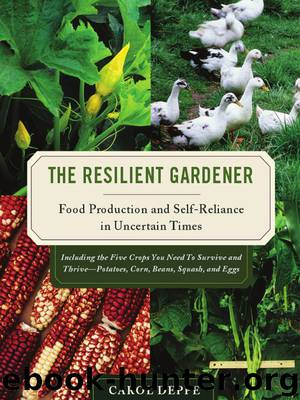The Resilient Gardener by Carol Deppe

Author:Carol Deppe
Language: eng
Format: epub
Publisher: Chelsea Green Publishing
Potatoes and Adventures in Resilience
Spring 2008. For storable staple crops Nate and I plant a cornbread corn patch, a polenta corn patch, beans, winter squash, drying squash, and lots of potatoes. There is a plague of birds. They pull up and eat all the corn as soon as the seedlings emerge. Farmers throughout the region lose their sweet corn plantings to birds and must replant. Nate replants, but the bird plague continues. He saves the replanted polenta patch by camping out in it with a shotgun. The cornbread and polenta patches are too far away from each other for Nate to protect both. We decide to sacrifice the cornbread and protect the polenta. Others throughout the region lose the second plantings of sweet corn and give up, just planting cover crops. Our potatoes emerge and grow vigorously and happily with no particular attention from us.
Meanwhile, summer doesn’t come. It rains and stays cold for more than an extra month, slowing and delaying most warm-season crops throughout the region. Our corn, squash, and beans all lag. Our potatoes, however, are thriving. They love cold, wet weather. Just looking at the vigorous plants is cheering. They had no fertilization other than our plowing under a grass-clover cover crop. The tilling was so shallow it was difficult to get the seed tubers more than just barely covered initially. Hilling up is late. The plants got no pampering. Yet they thrive.
A rabbit starts mowing down the bean plants. It doesn’t bother the potato plants, which have poisonous tops.
After a slow start to summer, we then have a cooler-than-average remainder of the summer. Our corn, beans, squash, and tomatoes are further delayed. The potatoes are apparently delighted with the cooler summer. We rediscover what Irish and other European peasants learned generations ago during the erratic weather of the Little Ice Age. The very weather that delays or damages grains and many other crops is exactly the kind of weather that allows potatoes to thrive and produce especially well. So growing potatoes and a grain crop at the same time provides a balance that contributes resilience to weather extremes.
Our winter squash crop is late. Fortunately, fall freezes come late and we get a good crop. But our squash are still curing indoors in October and most of November. And our polenta corn is still on the cob, still drying out enough to shell. But Nate and I don’t mind. We are too busy having fun with our potatoes. We have hundreds of pounds of potatoes tucked away in bags on the shelves in the garage, a few hundred pounds of ‘Yukon Gold’ as well as good yields of several new varieties. We taste and explore and boil and bake and make hash browns and eat potatoes day after day. We excitedly compare notes about each new variety. Our potatoes satisfy us fully—body, mind, soul, and sense of adventure.
Download
This site does not store any files on its server. We only index and link to content provided by other sites. Please contact the content providers to delete copyright contents if any and email us, we'll remove relevant links or contents immediately.
| Container Gardening | Hydroponics |
| Organic | Propagation & Cultivation |
| Topiary | Urban |
| Water Gardens & Ponds |
Turbulence by E. J. Noyes(7935)
The Thirst by Nesbo Jo(6826)
Gerald's Game by Stephen King(4571)
Be in a Treehouse by Pete Nelson(3941)
Marijuana Grower's Handbook by Ed Rosenthal(3619)
The Sprouting Book by Ann Wigmore(3543)
The Red Files by Lee Winter(3367)
The Remains of the Day by Kazuo Ishiguro(3293)
Sharp Objects: A Novel by Gillian Flynn(2952)
Christian (The Protectors Book 1) by L. Ann Marie(2653)
Organic Mushroom Farming and Mycoremediation by Tradd Cotter(2626)
The Culinary Herbal by Susan Belsinger(2429)
Stone Building by Kevin Gardner(2348)
The Starter Garden Handbook by Alice Mary Alvrez(2281)
Lilac Girls by Martha Hall Kelly(2257)
The Unlikely Pilgrimage of Harold Fry by Rachel Joyce(2216)
The Lean Farm Guide to Growing Vegetables: More In-Depth Lean Techniques for Efficient Organic Production by Ben Hartman(2096)
Urban Farming by Thomas Fox(2061)
Backyard Woodland by Josh VanBrakle(1894)
